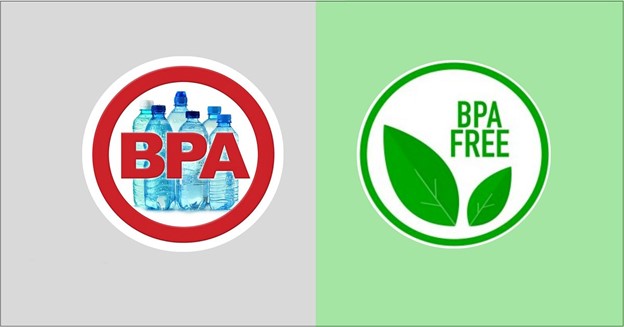BPA は食品や飲料を汚染する可能性のある工業用化学物質です。一部の専門家は、BPAは有毒であり、人々はBPAを避ける努力をすべきだと主張しています。しかし、本当にそんなに危険なのかまだ疑問に思っているのではないでしょうか?この記事では、 tssilicone.com BPA とその健康への影響に関する詳細情報を提供します。
1. BPA とは何ですか?
BPA、略称ビスフェノール A (化学式 (CH3)2C(C6H4OH)2) は、1891 年代にロシアの科学者によって発見された化学物質で、1950 年代までにはプラスチックやゴムの硬化に使用されていました。
BPA は主に、他の多くのプラスチックやゴムの中でも、ポリカーボネート (PC プラスチック) やエポキシ樹脂の製造に使用されます。実際の製品には、水筒、スポーツ用品、CD や DVD、水道管、さらには幼児向けの低品質のおもちゃなども含まれます。...
現在、BPA を含むプラスチックやゴムは、食品容器、哺乳瓶、その他の製品の製造に一般的に使用されています。 BPA は、金属の腐食や破損を防ぐために食品容器の内層に塗布されるエポキシ樹脂の製造にも使用されます。
2. BPA を含む製品は何ですか?
BPA が含まれる可能性のある一般的な製品には次のものがあります。
• 商品はプラスチックで梱包されております。
• 缶詰食品。
• トイレタリー。
• 女性用衛生製品。
• 感熱レシート印刷用紙。
• CD と DVD。
• 家電。
• 眼鏡。
• スポーツ用品。
• 詰め物。
多くのラベル付き製品には BPA が含まれていないことに注意してください。これは、単に製造会社が物質を BPS (ビスフェノール S) および BPF (ビスフェノール F) に置き換えただけであるためです。
しかし、たとえ低濃度のBPSおよびBPSであっても、BPAと同様に細胞の機能を危険にさらす可能性があります。したがって、BPAフリーのペットボトルを選択することは正しい解決策ではありません。 リサイクル 3 ~ 7 のラベルが付いているプラスチック製品、または「PC」という単語が付いているプラスチック製品には、ほぼすべてに BPA、BPS、または BPF が含まれています。
プラスチックやゴム製品を購入する場合は、プラスチックのマークを確認し、上記の 3 種類を避けてください。これらは通常、メーカーによって、製品の下部にある 3 つの矢印の三角形の中に指定された番号で示されます。
3. BPA はどのようにして体内に入りますか?
BPA への主な曝露源は食事です。
コンテナの製造時に、すべての BPA カウントがしっかりと関連付けられているわけではありません。これにより、BPA の一部が表面に逃げて、容器内の品物と接触することができます。特に、温度や剣尾や酸を含む食品などの触媒作用にさらされた場合、放出される BPA の量はさらに多くなります。
ボトル入り飲料水からの BPA

たとえば、最近の研究では数名のボランティアを募集し、参加者が包装食品を避けた場合、3 日後に尿中の BPA レベルが 66% 減少したことがわかりました。
別の研究では、参加者に5日間毎日生鮮食品または缶詰のスープが与えられました。 缶入りスープを摂取した人の尿中に検出されたBPAの量は、生鮮食品を摂取した人よりも1,221%多かった。
さらに、世界保健機関は、母乳で育てられた乳児の BPA レベルは、BPA ボトルで育てられた乳児の BPA レベルの最大 8 分の 1 であると報告しています。
4. BPA は健康に悪影響を及ぼしますか?
多くの専門家はBPAは有害だと主張していますが、これに同意しない人もいます。
以下のセクションでは、BPA が体内でどのような働きをするのか、そしてそれが依然として議論の余地がある理由について説明します。
4.1 BPA の生体力学
BPA は、ホルモンのエストロゲンの構造と機能を模倣すると考えられています。
BPA はエストロゲンに似ているため、エストロゲン受容体に結合し、成長、細胞修復、胎児の発育、エネルギー活動、生殖などの体のプロセスに影響を与える可能性があります。
さらに、BPA は、甲状腺受容体の機能を変化させるなど、他のホルモン受容体に結合する可能性があります。
私たちの体はホルモンレベルの変化に非常に敏感であるため、エストロゲンを模倣する BPA の能力が体に影響を与えると考えられています。
4.2 BPA 論争。
上記の情報のように、多くの人はなぜ BPA が禁止されなければならないのか疑問に思っています。
この種の物質の使用は、EU、カナダ、中国、マレーシア、特に乳児や幼児向けの製品で制限されています。
米国のいくつかの小委員会はこの種の化学物質に法律を適用しているが、連邦規制はまだ確立されていない。
2014年、米国食品医薬品局(FDA)は最新の報告書を発表し、1980年代の公式の1日当たりのBPA暴露限度を1キログラム当たり50マイクログラムとしたことを確認し、BPAがいつ許可されるかは影響しないと結論付けた。
しかし、げっ歯類の研究では、BPA の悪影響は許容レベルでははるかに低いことが示されています。
さらに、サルを対象とした研究では、人間と同等のレベルのBPAレベルがサルの生殖に影響を与えることが示されています。
調査の結果、産業企業が資金提供した研究ではbpaの不祥事は示されていないことが明らかになった。一方、産業企業による資金提供を受けていない研究の 92% では、BPA の信じられないほどの悪影響が判明しました。
4.3 BPA は男性と女性の両方で不妊症を引き起こす可能性があります
BPA は生殖能力の多くの側面に影響を与える可能性があります。
ある研究では、頻繁に流産する女性は、妊娠に成功した女性よりも血中の BPA 濃度が 3 倍高いことが観察されました。
さらに、生殖補助医療を行っている女性を対象とした研究では、高レベルのBPAにより、これらの女性の卵子の生産が減少し、妊娠を遂行する能力が最大2倍低下することが示されています。
体外受精(IVF)を受けているカップル、つまり夫の BPA 濃度が高いカップルでは、胚の質が 30 ~ 46 パーセント低かった。
別の研究では、BPAレベルが正常の3〜4倍高い男性は精子の濃度と数が低いことがわかりました。
さらに、中国のBPA会社で働く男性は、他の男性に比べて勃起が最大4.5倍難しく、性的満足度が低いと主張している。

4.4 幼児に対する悪影響。
ほとんどの研究(すべてではありません)では、母親が職場でBPAに曝露された幼児は、母親がこの物質に曝露されなかった子供よりも出生時の体重が0.2kg少ないことが判明しました。
BPAに曝露された親から生まれた赤ちゃんは、肛門から生殖器までの距離も短く、これは胎児の発育中にホルモンが影響を受けていることを示しています。
さらに、BPA レベルが高い母親から生まれた赤ちゃんは、多動、不安、うつ病になりやすい傾向があります。これらの子供たちは、1.5 倍の感情反応と 1.1 倍の攻撃性も示しました。
最後に、幼少期に BPA にさらされると、前立腺がんや乳組織がんの可能性が高まるとも考えられています。
しかし、多くの動物研究は人間に対する BPA の影響が非常にマイナスであることを裏付けていますが、人間での研究は決定的ではありません。

4.5 心臓病および 2 型糖尿病と関連しています。
人間を対象とした研究では、BPA レベルが高い人では高血圧のリスクが 27 ~ 135% 高いことが示されています。
さらに、BPAに関連する1,455人のアメリカ人を対象とした調査では、心臓病のリスクが18~63パーセント高く、糖尿病のリスクが21~60パーセント高いことが判明しました。
別の研究では、BPA レベルが高いと、2 型糖尿病を発症するリスクが 68 ~ 130% 高いと関連しています。
BPA レベルが高い人は、メタボリック シンドロームや 2 型糖尿病の主な原因であるインスリン抵抗性のリスクが最大 37% 高いことがよくあります。
しかし、BPA とこれらの症状との間に関連性がないことを示す研究がいくつかあります。

4.6 肥満のリスクが増加する可能性があります。
肥満女性は通常、標準体重の女性よりも BPA レベルが 47% 高くなります。
いくつかの研究では、BPA レベルが高い人は肥満である可能性が 50 ~ 85 パーセント高く、ウエストラインが正常より大きい可能性が 59 パーセント高いと報告されていますが、すべての研究がこの発見に同意しているわけではありません。同様の兆候は子供や青少年にも見られます。
ただし、出生前曝露は動物の体重増加と関連しています。これは人間では実際には確認されていません。

4.7 他の健康上の問題を引き起こす可能性があります。
BPA への曝露は、次のような多くの健康上の問題にも関連しています。
多能性卵巣症候群(PCOS):多能性卵巣疾患のある女性では、そうでない女性と比較してBPAレベルが46%高かった。
- 早産: BPA レベルが正常より高い女性は、37 週未満で出産する可能性が 91% 高くなります。
- 喘息: 出生前に BPA にさらされると、生後 6 か月未満の乳児における喘鳴のリスクが 130% 高くなります。子供の頃にBPAにさらされると、喘鳴が後々まで続くことがあります。
- 肝機能: BPA レベルが高いと、肝酵素異常のリスクが 29% 増加します。
- 免疫機能: 高レベルの BPA も免疫システムの低下に寄与します。
- 甲状腺機能:高BPAレベルは甲状腺ホルモン異常とも関連しており、甲状腺機能が損なわれていることを示しています。
- 脳機能: BPA (米国環境保護庁によって安全性が評価されている) に曝露されたアフリカミドリザルは、脳細胞間の接続の喪失を示しました。

4.8 BPAへの曝露を減らす方法。
この種の物質が持つあらゆる悪影響を伴います。おそらく BPA には近づかないほうがよいでしょう。 BPA を除去するのは困難ですが、この種の化学物質への曝露を最小限に抑える方法がいくつかあります。
4.8.1. BPAフリーのプラスチックを使用。
BPA フリーには、健康に危険な BPA が含まれていません。 BPA フリーの注意書きがあり、当局によって認定されたプラスチック製品は、特に食品と直接接触する場合に、人間が使用するのに安全な製品です。

4.8.2 安全な素材を使用した製品を使用します。
• 包装された食品の摂取を避ける:主に新鮮な自然食品を食べます。缶詰食品およびプラスチック包装に包装され、リサイクルラベル 3 ~ 7 または「PC」の文字が付いている食品の使用を制限します。
• ガラス製の容器で水を飲む: プラスチックや缶ではなくガラス瓶で売られている水を購入し、プラスチック製の容器ではなく小さなガラス製のグラスを使用します。
• BPA を含む製品から遠ざける: レシートには BPA が多量に含まれているため、レシートへの接触をできるだけ制限してください。
• お子様に購入するおもちゃ、特に小さなお子様が噛んだり口で吸ったりできるおもちゃは、必ず BPA フリーの素材で作られていることを確認してください。
• プラスチック製の容器を電子レンジにしないでください。ガラス製の容器を使って食品を再加熱し、ストックしてください。
• 乳児用ミルクを購入する

BPA 毒性の明らかな証拠として、BPA やその他の食品毒素への曝露を徐々に制限することが重要です。特に、妊娠初期においては、妊婦にとって BPA への曝露を避けることが有益です。時々BPAから作られたペットボトルの水を飲んだり、缶詰を食べたりすることについては、まったく心配する必要はありません。
ただし、プラスチック容器をやめて BPA フリーの容器を使用すると、ほとんど手間がかかりませんが、健康上の大きな利点が得られます。
新鮮で純粋な食品を食べることを目標にすると、自動的に BPA への曝露を制限することになります。

この記事を通じて、BPA の危険性と計り知れない害についていくらか学びました。 Topsheng Silicone は、シリコーン製品の製造 (シリコーンが何であるかを知るため) における強固な基盤と豊富な経験を持つ会社です。特に高品質で医学的にテストされたシリコーン製品を製造しており、完全に BPA フリーで、お客様の要件に応じて色や形状を調整できます。
Topsheng Silicone は、押出成形、成形、射出成形などの豊富な経験と生産技術を備えた、シリコーン製品と部品の大量製造を専門としています。高度な技術と職人技で、お客様のご要望に応じてあらゆる種類のシリコーン製品を生産することもできます。「アイデアがある限り、私たちはすべての製品を提供します」をモットーに、最も困難なご要望にも自信を持って応えます。それを実現するつもりだ。」
詳細については、またアイデアを策定してすぐに実装するには、今すぐお問い合わせください。
電話番号: 0867571038.
メール: sales@tssilicone.com
ウェブサイト: tssilicone.com.
住所:ホーチミン市、ホックモン区、タン・トイ・ニ1、210
BPA。発がん性因子